For more than 400 years, humans finally "see" the depths of the universe ...
Author:Look at the think tank Time:2022.07.28
On July 20, the British "New Scientist" magazine reported that the data provided by the United States and Danish researchers used the data provided by the James Weber Space Telescope and found that it may be the oldest galaxy that is by far-GLASS-Z13.
Existing data show that the galaxy is about 13.5 billion light years before the earth, and was born 300 million years after the Big Bang. However, researchers said that this result still needs to be further observed.
Earlier, the oldest galaxy record was maintained by the GN-Z11 galaxy, about 13.4 billion light years from the land, observed by the Hubble Space Telescope.
From 1609 Gali's looking up at the starry sky, in 2016, "China Sky Eye" Fast was completed, and then in 2021, the "Pigeon King" Weber telescope rose smoothly. Human exploration of the universe had gone through more than 400 years of journey. , Uncle Ku takes you to review.
Text | Xie Fang Watch Think Tank Observer
This article is a comprehensive editor -in -chief of looking at the think tank.
1
Stars for more than 400 years
In 1608, Hans Lipperhey, a Dutch glasses, invented the telescope. The following year, Galileo Galilei (Galileo Galilei) used a tube to make a lens barrel, and a convex lens and concave mirror were embedded in both ends. A telescope with a magnification of 3 times was born. At the end of the year, he increased the magnification to 32 times to observe space.
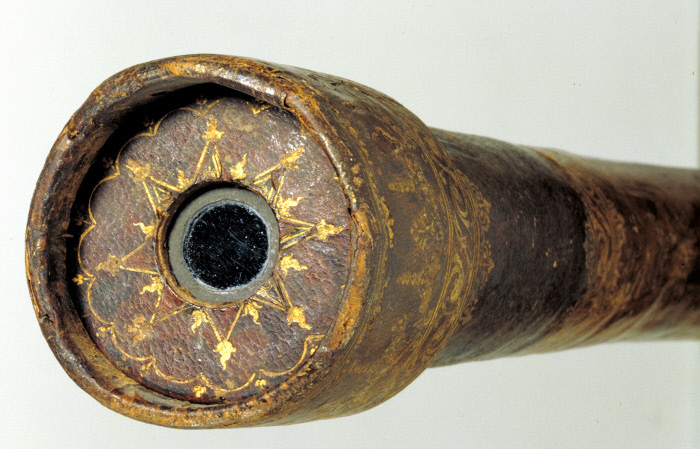
The telescope made by Galileo.
Our understanding of the position of the universe and ourselves in the universe has changed greatly.
In the past 400 years, countless scientific giants have dedicated themselves, and the observation ability of telescope has made rapid development.
Galileo produced a refracted telescope. Through them, he discovered the unevenness of the moon surface, discovered Saturn halo, discovered the image of heaven such as sunspots in the sun, and opened up a new era of relying on observations and experiments to explain the celestial movement. "Foundation.
However, the refracted telescope has the disadvantages of color dispersing (which will blur the object) and the difference (will deform objects).
In 1668, Newton made the first reflecting telescope, which solved the problem of scattering. Since then, the refracted telescope and reflex telescope began to develop parallel. British astronomer Wilhelm Herschel created more than 400 reflective telescopes. In 1781, he discovered Tianwang Xing and became the first person to determine the shape, size and star of the Milky Way.
In 1895, Clark's father and son in the United States created the Ye Kaisi telescope with a caliber of 102 cm. Because the larger the glass lens, the more difficult to make, the huge weight, and the easily deformation of the central part, which affects the quality of observation. The Ye Kaishi telescope does not make humans have an update of the universe. The largest refracted telescope in the world.
Note: On June 12, 2022, the launching ceremony of the Tibet Astronomy Museum was held in Lhasa. After completion, it will be the highest altitude of the World Museum in the world. At that time, the one -meter -class optical astronomical telescope will be equipped, which will become the world's largest refracted telescope.
In 1930, German optical scientist Schmidtb.v. Combines the advantages of refracted telescope and reflex telescope to make the first reflex mirror. Since then, this type of telescope is called "Schmidt Telescope". With the high -definition of reflective telescope and the large field of view of the refracted telescope, Schmidt Telescope has become a "Sky Police Police" -s used to do heavenly work. After discovering the target, use other telescopes to observe in -depth observation.
During this period, due to the development of industrial technology, the reflex mirror made of silver plating or aluminum -plated glass materials can avoid the problem of rusting the metal mirror and the defects of low reflection rates. The reflective telescope has once again ushered in the climax of development. In 1948, the 5.08 -meter -caliber Haler telescope was completed in the Palomar Observatory, USA, marking the development of an astronomical telescope to its unprecedented peak. Its largest reflexive telescope status in the world was completed until 1993 that it was completed by the Kaike Telescope (located in Hawaii and 10 meters) that it was surpassed.
Note: In 1976, the Soviet Union built a BAT-6 reflecting telescope with a caliber of 6 meters, but its operation was defective.
The above review is just a optical telescope, that is, collecting "light" through glass lenses to observe space, and most of the visible light targets.
2
Hundred meters of "giant eyes"
While the optical telescope is booming, the discovery of another signal in the universe has spawned a radio telescope.
In 1931, when K.G.JANSky, the Bell Laboratory of New Jersey in the United States, searched for long -distance radio communication interference, unexpectedly found that there was a radio interference that appeared every 23 hours, 56 minutes and 04 seconds on the wavelength of 14.6 meters. Essence
After more than a year of measurement and analysis, the article interrupt published by Yangsky in 1932: This is radio radiation from the center of the galaxy. The new era of radio wave studies of celestial bodies has opened.
Glass lenses that do not use optical telescopes with optical telescopes, but use huge antenna to capture invisible and invisible radio waves. By analyzing the received radio radiation information, the location, images, movements, and changes in various celestial bodies will be fully revealed at any time. The situation. The rotating antenna array of 30.5 meters and 3.66 meters height used by Yangsky at the time, which can be seen as the prototype of a radio telescope. In 1937, American astronomer G.Reber created the world's first parabolic antenna -type radio telescope. The development of radar technology during World War II promoted the rise of post -war radar modification of radio telescopes.
On July 21, 2022, the "China Eye" 500m caliber spherical radio telescope in Guizhou Qiannan Prefecture (shooting during maintenance, drone photos). Figure | Xinhua News Agency
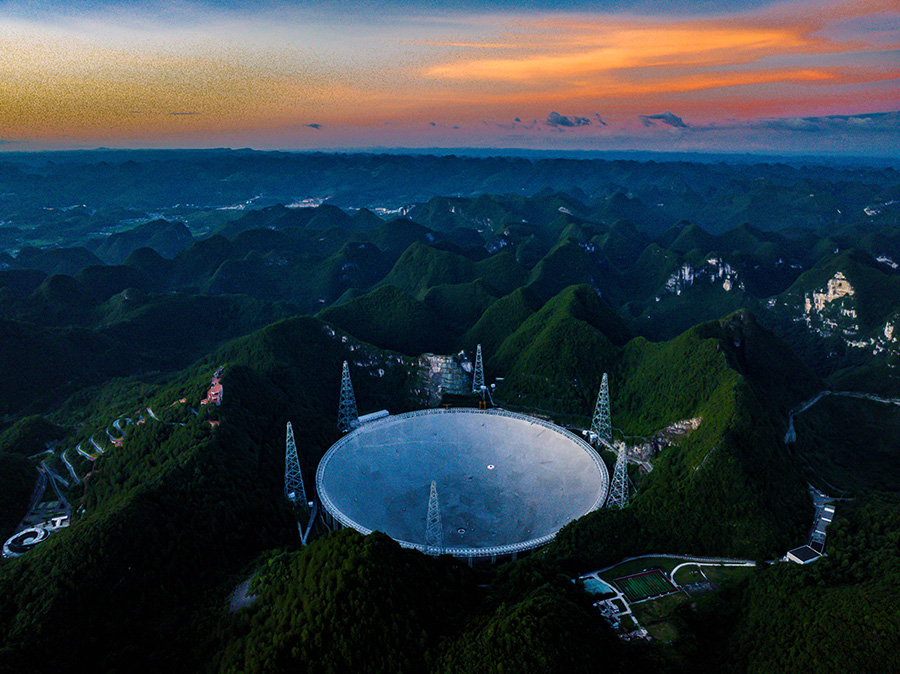
Since then, the radio telescope has developed towards greater and stronger, and the caliber has continued to increase. From the British Manlofer radio telescope with a diameter of 76 meters in 1957, by 1963, in 1963, the Ares Boto RF, USA, which reached 305 meters in diameter of 305 meters. Then, in 2016, the Chinese FAST, which reached 500 meters of the spherical diameter, refreshed technology and architectural miracles again and again.
Note: Arcord -Boto Telephone Telescope was once the world's largest single -sided -caliber radio telescope. Until 2016 was replaced by Fast of China and retreated to the second. On December 1, 2020, due to the years of disrepair and other reasons, the Ares Bo RF collapsed. Uncle Ku had published "The United States collapsed, can China be okay? "introduce.
Of course, the radio telescope also made great contributions. In the 1960s alone, it directly brought four major milestone astronomical discovery of star, pulse, interstellar, and cosmic microwave background radiation. Learn award.
When a large single -caliber radio telescope develops to a certain degree, the new observation technology is born again. New radio interference technologies such as integrated pores, radio interference instruments, and long baseline interference instruments allow scientific researchers to extract useful signals from noise, expand observation coverage, and convenient imaging.
For example, the United States has a large -scale comprehensive aperture radio telescope, the Dutch Westbolk comprehensive pore diameter telescope, and Australian telescope. These telescopes can use the principle of interference to use several telescopes to achieve an observation performance of a telescope with a long telescope with a long telescope baseline.
Located in the desert of the New Mexico State in the United States, a large array of integrated pores in the radioscope of the radio -telescopic mirror, consisting of 27 radio antennas with a caliber of 25 meters. It is the world's largest integrated pore diameter radio telescope. Objects of size.
The goals of multi -antenna radio intervolution and long baseline interference instruments are more magnificent, which can make the caliber of the telescope reach the scale of the earth.
With the ground telescope of optical telescope and radio telescope, why does humans launch a telescope to space?
3
Outside the atmosphere
Because the atmosphere exists, the earth is warm, comfortable and livable, and various creatures can be exempted by meteor and external radiation attacks. However, for astronomical observations, the atmosphere has become an obstacle.
Among them, the most affected ground observation is the light and light effect of atmosphere. Due to the absorption and scattering effect of atmosphere, the strength of celestial bodies will be reduced after crossing the atmosphere. Atmospheric lighting is related to the wavelength of radiation, and the anti -lighting effect on short -wave radiation is larger than the long -wave radiation.
Because the atmosphere is light, only the radiation of some bands can penetrate, or partly penetrated the atmosphere to reach the ground, and was eventually captured by the telescope. The range of these bands is called the atmospheric window.
Atmospheric windows also include optical windows, infrared windows and radio windows.
300 to 700 nanometer visible light wave sections are optical windows. Optical telescope can observe colorful celestial bodies with different colors through this window.
The situation of infrared windows is more complicated. The atmosphere is a translucent window for 17 to 22 microns, while 22 microns to 1 mm are completely opaque, but some infrared windows of the latter can be found on the mountain.
For a radio wave from 10 MMS to 300, the earth's atmosphere is transparent or partially transparent. This is the radio window. Therefore, the invention of the radio telescope make up for the observation range of the optical telescope.
And some band radiation will be absorbed by the atmosphere before reaching the ground, and the ground is not observed, such as ultraviolet, X -ray and gamma rays.
In addition, the atmosphere can produce a fuzzy effect, making it difficult for the resolution of the best large telescope to approach the optical diffraction limit. If the same large telescope is placed in a vacuum environment, the resolution can be increased by 10 times.
In order to get rid of the influence of the atmosphere on astronomical observation, humans try to choose places with high altitude and good observation conditions to establish an observatory, and on the other hand, starting to think of sending astronomical telescopes to space.
In 1923, German scientist Hermann Obertt published an article that mentioned that it could use a rocket to send telescopes into space. This was the earliest concept of human beings proposed to bring an astronomical telescope out of the earth.
In 1946, Lyman Spitzer, a celestial physicist, published a paper "Advantages of Astronomical Observation outside the earth", which introduced the scientific value of the space telescope. With the continuous efforts of Spiezer, in 1969, the large space telescope project was approved by the National Academy of Sciences, and humans really started the implementation of the space telescope plan. However, the manpower and material resources required to develop a large space telescope can be taken far from one country. In 1975, the European Space Administration joined with funds and technology. In 1977, the U.S. Congress finally approved funding for the Space Telescope project.
In the 1980s, the National Aeronautics and Space Agency (NASA) started a series of space astronomical projects, including the "Great Observatory" plan. The plan launched a total of four large space telescopes working in different bands, and named after the names of 4 American scientists Hubble, Conopon, Chandella, and Sipztiz to commemorate their outstanding contributions.
In April 1990, the Hubble Space Telescope was successfully sent to space by the "Discovery" spacecraft. The satellite weighed about 11.5 tons, the caliber of the telescope was 2.4 meters, and the cost was 2.1 billion US dollars.
Hubble Space Telescope.
In more than 30 years of work, Hubble Telescope has experienced 5 astronauts' maintenance work, constantly updated cutting -edge scientific instruments, and obtained a large amount of valuable discovery. For example, the galaxy of more than 10 billion light years is observed, confirming that there is a large quality black hole in the center of the galaxy, shooting the galaxy and combining images, and found that the stars that are 10 million times brighter than the sun, etc., greatly enhance the human understanding of the size and age of the universe. , Found dark matter.
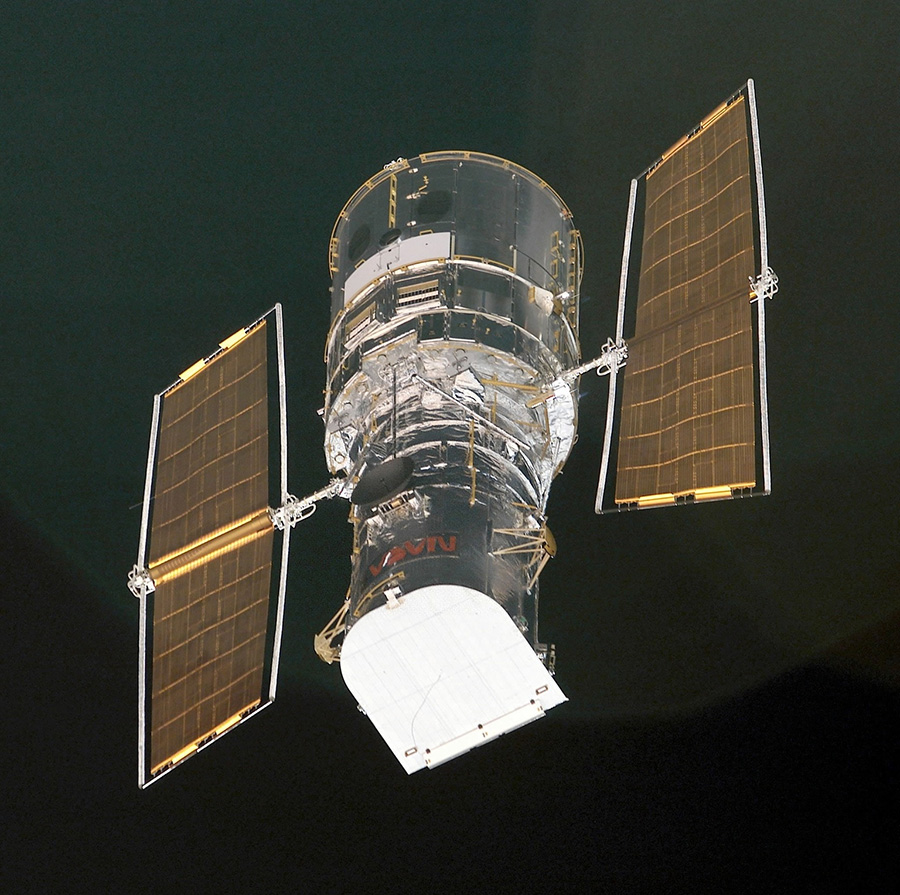
On June 13, 2021, the Hubble telescope stopped running due to the failure of its effective load computer, and it was not fully resumed until July 17.
In April 1991, the Compton gamma ray space mirror, which weighed about 16 tons and cost $ 760 million, was sent to the orbit. The telescope expanded the detection range of celestial gamma 300 times. The first sky patrol observation on the gamma ray band. In the 9th year of the track, it allowed humans to understand how black holes caused X -rays and gamma rays for the first time, observing anti -substance particles cloud in the center of the galaxy, and so on.
However, at the end of 1999, a pose control positioning gyroscope in the Convedon gamma ray space mirror failed and could not be repaired in time. In order to prevent the satellites from falling into a dense population, NASA was artificially crashed on September 4, 2000.
In July 1999, Chandra X -ray space mirror entered space and cost $ 1.5 billion. It draws the X -ray source map throughout the day with higher accuracy and sensitivity, and has achieved unprecedentedly important results in X -ray observations of various celestial bodies.
In August 2003, the last one of the four large space telescopes, the Sipzerzo Space Telescope, was successfully launched at a cost of 800 million US dollars. It adopts the sun orbit, which can work under extremely low temperature conditions, completely avoiding the interference from infrared radiation from the earth, which is conducive to the detection of extremely young celestial bodies. Since then, it has successively observed the first generation of stars that have formed after the Big Bang of the Universe, captured the first image of the exterior planet of the solar system, and took the intensive attendants of the supernova ruins and the central area of the galaxy, and so on. On January 30, 2020, Sipzerzo Space Telescope retired.
These four large space telescopes are known as the "Four Great Kings", which has expanded human horizons without unprecedentedly, and promoted the development of multi -band astronomy.
4
Back to the starting point of the universe
The James Weber Space Telescope Project was launched in 1996. It was originally called "Next Generation Space Telescope (NGST)". It was changed to the current name of JWST in 2002 to commemorate James, the second director of the National Aeronautics and Space Agency, James · James Webb's key leadership role played in Apollo's plan.
Weber telescope.
The Weber telescope absorbs the advantages of the Hubble Space Telescope and the Spirzzer Space Telescope. The initial budget of the project was only 500 million US dollars, and it was planned to launch in 2007. However, in 2005, the design plan was greatly adjusted, and the launch time was forced to delay. Since then, the launch time of the Weber telescope is extended again and again, from 2014 to 2018, and then to 2019, and later extended to 2020, which is also nicknamed the "Pigeon King". reason.
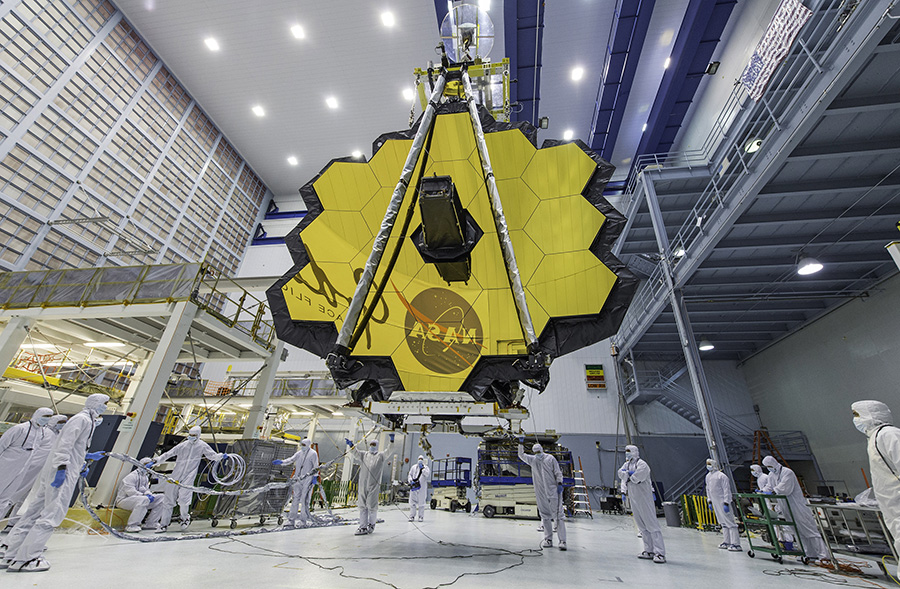
Finally, at 20:20 on December 25, 2021, Beijing time, this large -scale The astronomical telescope uses the Ali An-5 large carrier rocket to launch at the French Guyana Kuru Aerospace Launch Center. One month later, it successfully entered the tracking track around the second Ragron day point around the Japanese and ground system.
Looking back on the 25 -year construction process, the total cost of Weber telescope is 10 billion US dollars. It is one of the most expensive scientific platforms built by human beings. It is also the largest, most complicated, and most powerful space telescope.
As an optical telescope, the main mirror of the Weber telescope is a gold -plated mirror of 6.5 meters in diameter and 18 huge hexagonal lenses. The total area reaches 25.4 square meters, which is more than 6 times that of the Hubble telescope. This is also its main component. It is a huge sunshade plate with the main mirror surface, which is made of a very complex composite material. It looks like a silver plastic film. The thickness is only the diameter of human hair, but it has a high strength. There are 5 layers of sunshade, which is as large as a tennis court in full. It can reduce the heat from the sun to one -million -dollar. It can ensure that the Weber telescope is always in a low -temperature environment.
Because the mirror diameter of the Weber telescope has surpassed the maximum diameter of the Rockets, when launching, its 18 hexagonal lenses and sunshade boards are folded. When entering the space track, it is expanded in the instructions.
In addition, the Weber telescope also needs to carry other various refrigeration equipment to prevent the thermal radiation generated by itself, thereby ensuring that the camera can work at low temperature. Under normal circumstances, the mirror temperature should be kept about minus 220 degrees Celsius.
Compared with Hubble, the Weber telescope has a longer wavelength coverage, and the sensitivity and resolution are also greatly improved. It is better to observe the infrared rays and can supplement and expand the discovery of the Hubble telescope. However, unlike Hubble, the Weber telescope did not have the opportunity to repair it about 1.5 million kilometers from the earth.
At the end of 2020, the rising of the Weber telescope, and scientists in 44 countries have submitted more than 1,000 applications, accounting for two -thirds of the one -year workload of Weber telescope. However, these applications need to be approved strictly.
On July 11, 2022 local time, NASA announced the first full -color photo taken by Weber telescope in advance.
Weber's first deep field was SMACS 0723, which was full of thousands of galaxies -including the weakest object observed in infrared. Picture source: NASA
In this full -color photo, it contains the darkest celestial body observed in the infrared band and thousands of galaxies. The protagonist is an astronomical SMACS 0723 galaxy group, 4.6 billion light years from Earth. The total quality of this galaxy group is like a gravitational lens, which enlarge the galaxy that is much far behind. The earliest starlight captured by this photo is only 500 million years since the Big Bang.
At present, the history of the universe knows about 13.8 billion years, which means that the first photo of the Weber telescope has almost captured the light from the starting point of the universe.

The operating time of the Weber telescope is at least 10 years. After the research of the first generation of stars, galaxies, the formation and evolution of the galaxy, the formation of star and planetary system, and the outer planet after studying the Big Bang of the Universe. I believe that in the future, it will also bring us greater surprises.
According to the plan, my country will launch the "Sky Tour" optical cabin with the space station in 2023. It is known as the Chinese version of the Hubble Space Telescope. According to relevant reports, the optical cabin of the "Sky Tour" is equipped with a optical telescope with a caliber of 2 meters, which is comparable to Hubble, about 0.15 cents, but the field is more than 300 times that of Hubble, which means that its sky patrol efficiency is efficient higher. However, the band of its detection is mainly visible light.
Dai Yu, a researcher at the National Observatory of the Chinese Academy of Sciences, said that the exploration scope of Chinese astronomical telescope is mainly concentrated in three bands: optics, radio power and X -ray. There is no plan to build infrared space telescopes. In the direction of infrared astronomy, China's talent reserves and the accuracy of infrared detectors in the instrument have a small gap with foreign countries.
Nan Rendong, the late Chinese astronomer and the person in charge of Fast, said, "The reason why humans stand out, evolved from low life to the present, and civilization has appeared. He has a spirit of unknown exploration."
Humans' reluctance to explore space has promoted the continuous progress of telescope technology, and the development of telescopes further expands human vision and never stops.
Reference materials:
1. "Back to the starting point"? NASA announced the first full-color photo taken by James Weber Space Mirror | WeChat public account "CGTN" .2022-7-12
2. Telescope and astronomy: 400 years of review and prospect | Su Dingqiang. Physics. 2008, (12)
3. From looking up at the starry sky to the space -commemorating Galileo with an astronomical telescope for astronomical observation for 400 years | Lu Yixiang. Astronomy Progress. (01)
4. "Four Heavenly Kings" came into the air | Zhao Junliang. Natural and science, 2012, (04)
5. The "successor" of Hubble Space Telescope -James Weber Space Telescope | Golden Autumn. Science Enlightenment. 201, (08)
6. What is the end of the universe? A space telescope worth $ 10 billion, take these beautiful photos | Daily Economic News.2022-07-13
7. Application and expansion of optical knowledge in the 400 -year development of astronomical telescopes | Ning Changchun, Sonham Sanm University Physics. 2013,32 (10)
8. Weber telescope: Lightning in the universe | Dai Mingzhang. Science 24 hours .2021, (09)
9. Weber Space Telescope "First Show", "See" the initial light of the universe formed | Peng Danni. WeChat public account "China News Weekly" .2022-07-16
Uncle Ku Welfare
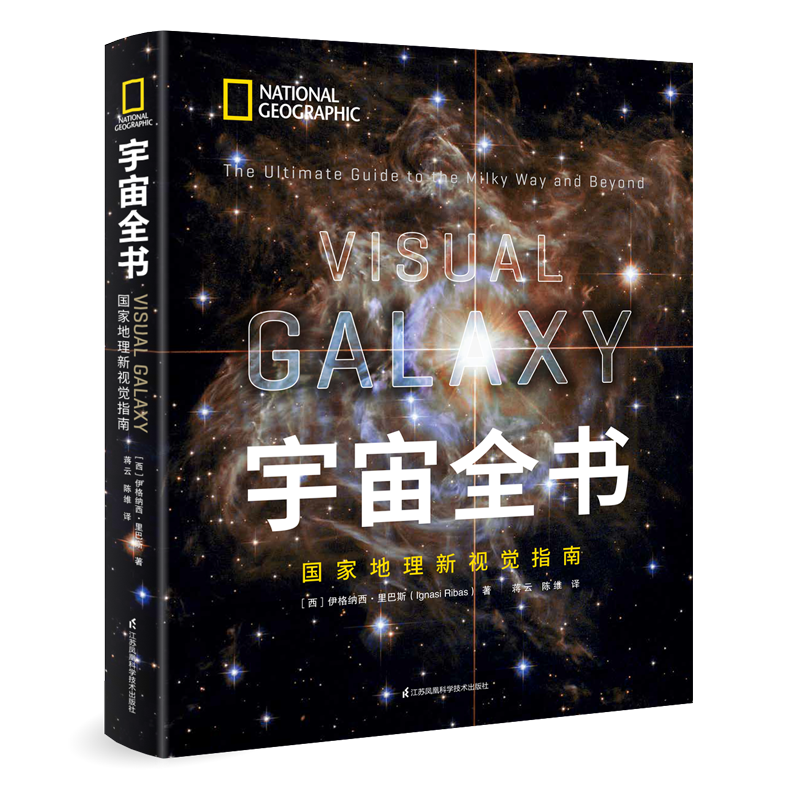

- END -
What is the owl with a toad mouth?| July 15th

Data-version = 0 data-vwidth = 1280 data-vHeight = 720 transcoding = 1 style = wid...
Create the Youth Association that will never end!The Disposal Center of the World Youth Scientist Summit was unveiled
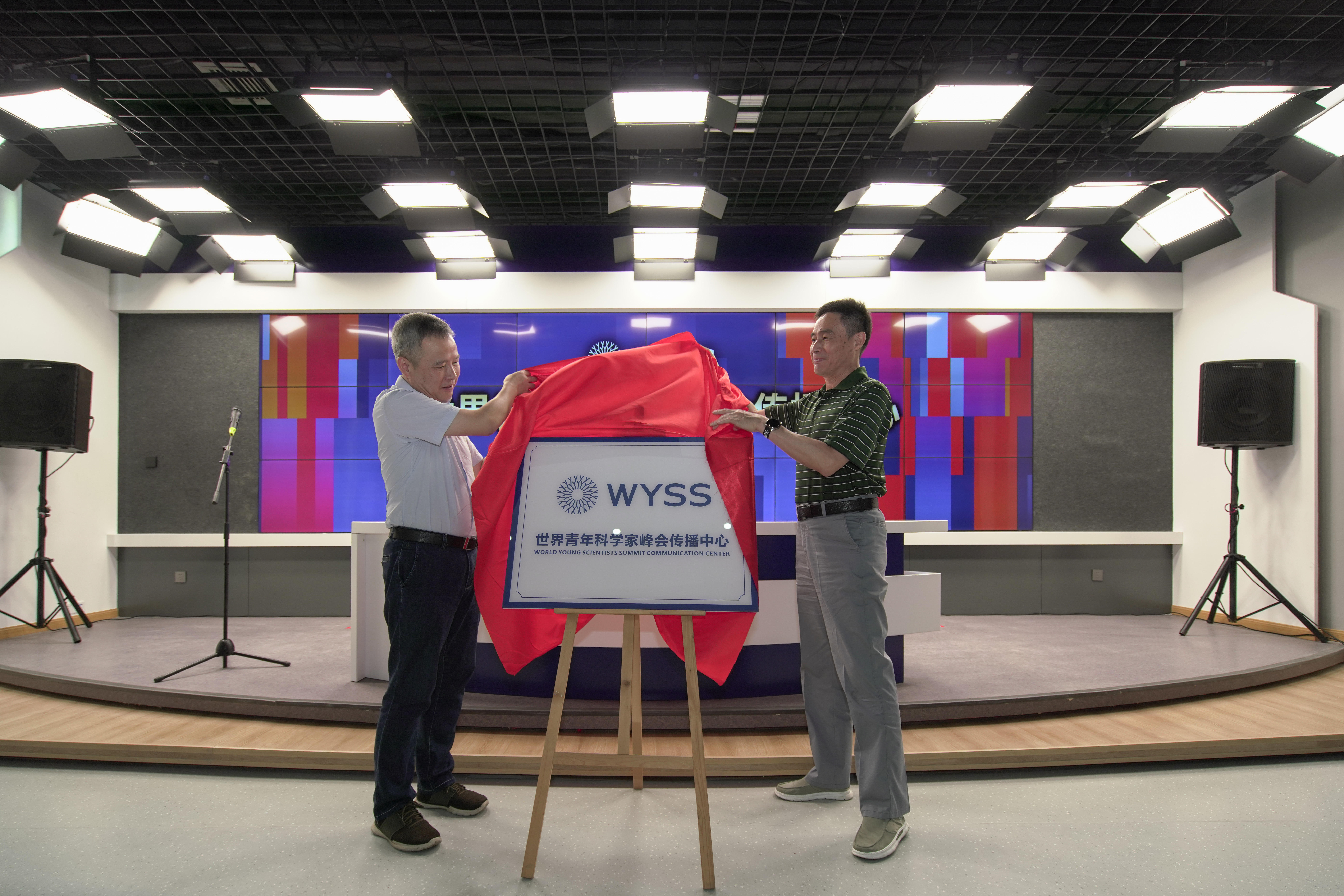
On the morning of July 20th, the World Youth Scientist Summit Communication Center...